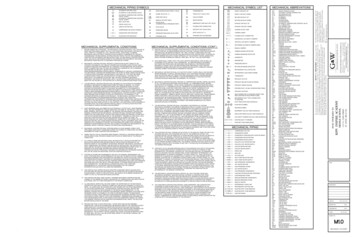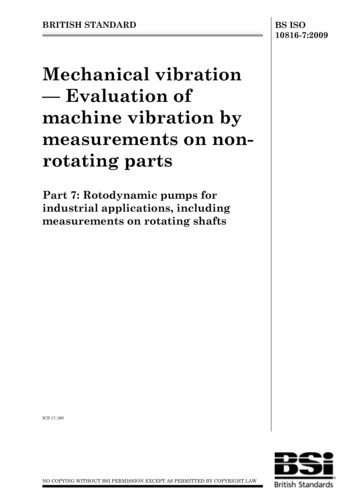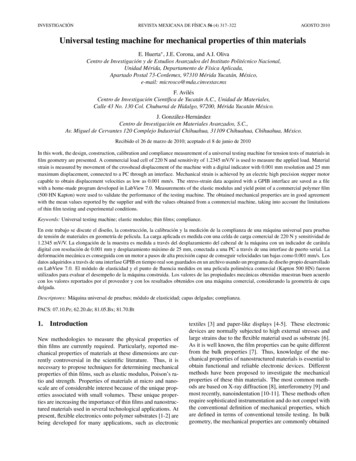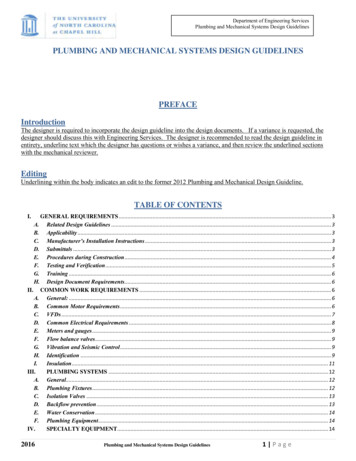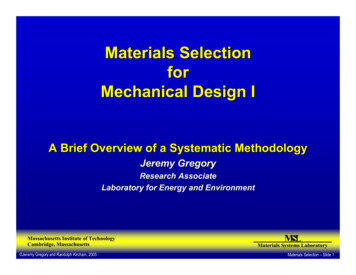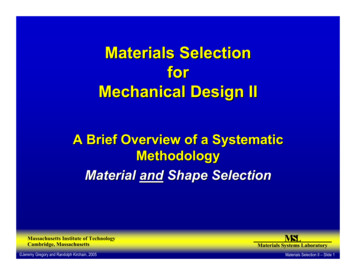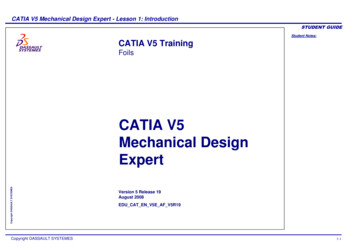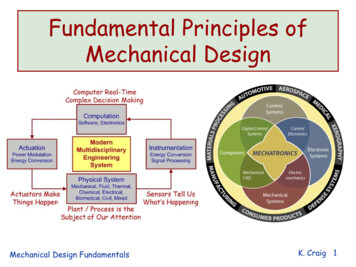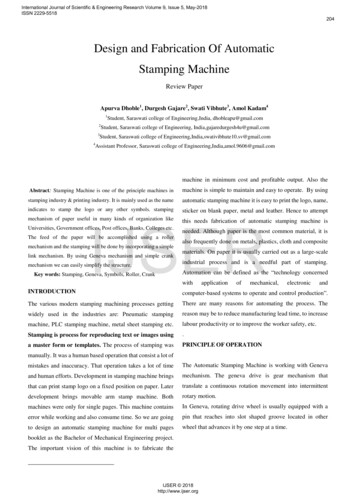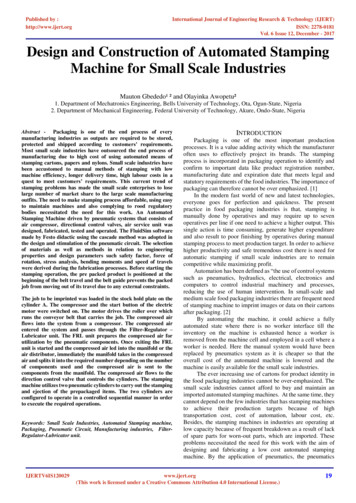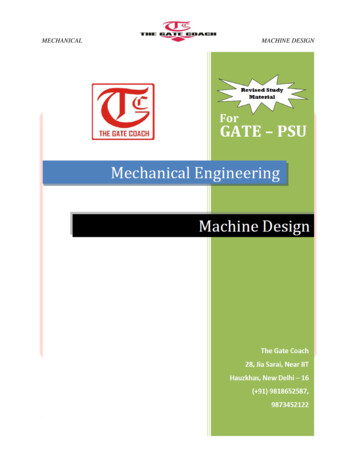
Transcription
MECHANICALMACHINE DESIGN1 P a geTHE GATE COACHAll Rights Reserved28, Jia Sarai N.Delhi-16 26528213,-9998
MECHANICALMACHINE DESIGNCONTENTS1DESIGN AGAINSTSTATIC ANDFLUCTUATINGLOADS2SHAFT, KEYSAND COUPLINGSIntroductionFactor of safetyStress concentrationStress concentration factorsReduction of stress concentrationFluctuating stressesFatigue failureEndurance limitFatigue lifeLow- cycle and high – cycle fatigueNotch sensitivityEndurance limit approximate estimationReversed stresses – design for finite and infinite lifeSoderberg and goodman linesModified gooman diagramGerber equationFatigue design under combined stressesImpact stressesCotter joint & knuckle joint6678899101010101112131314141516Transmission shaftsShaft design on strength basisShaft design on torsional rigidity basisASME code for shaft designDesign of hollow shaft on strength basisDesign of hollow shaft on rigidity basisKeysSaddle keysSunk keysFeature keyWoodruff keyDesign of square and flat keysDesign of kennedy keySplinesCouplingsMuff couplingDesign procedure for muff couplingClamp couplingDesign procedure for clamp couplingRigid flange couplings24242626272829292931313133333434353535362 P a geTHE GATE COACHAll Rights Reserved28, Jia Sarai N.Delhi-16 26528213,-9998
MECHANICALMACHINE DESIGNDesign procedure for rigid flange couplingBushed pin flexible couplingDesign procedure3WELDED JOINTS4RIVETED JOINTS5CLUTCHES373839IntroductionStress relieving of welded jointsClassification of weld jointsButt jointsFillet jointsOther types of weld jointStrength of butt weldsStrength of parallel fillet weldsStrength of transverse fillet weldsMaximum shear stress in parallel fillet weldMaximum shear stress in transverse fillet weldAxially loaded unsymmetrical welded jointsEccentric load in the plane of weldsWelded joint subjected to bending momentWelded joint subjected to torsional momentWelded joint subjected to fluctuating forces41414141414242424343444444454546Riveted jointsTypes of riveted jointsTypes of failureStrength equationsEfficiency of jointCaulkingLongitudinal butt joint for boiler shellCircumferential lap joint for boiler shellEccenrtically loaded riveted joint484849495050505254Classification of clutchesTorque transmitting capacityMulti-disk clutchesFriction materialsCentrifugal clutchesEnergy equationThermal considerations575758596162633 P a geTHE GATE COACHAll Rights Reserved28, Jia Sarai N.Delhi-16 26528213,-9998
MECHANICALMACHINE DESIGN6BRAKES7BELT & on of brakesEnergy equationsBlock brake with short shoeBlock brake with long shoeBand brakesDisk brakes66666667687071Geometrical relationshipsCondition of maximum powerSelection of flat belts from manufacturer cataloguePulleys for flat beltsArms of cast iron pulleyV – beltsSelection of beltsV – grooved pulleyChain drivesGeometric relationships74777878808081828383Basic types of screw fasteningCap screwsSetscrewsTerminology of screw threadsBolt joint-simple analysisEccenrtically loaded riveted jointEccentricload perpendicular to axis of bolt86868787888990Types of rolling contact bearingsStatic load carrying capacityStribeck equationDynamic load carrying capacityEquivalent bearing loadLoad life relationshipSelecton of bearing from manufacture catalogueSelection of taper roller bearingsDesign for cyclic loads and speedsBearing with a probability of survival other than 90%939494949495959697974 P a geTHE GATE COACHAll Rights Reserved28, Jia Sarai N.Delhi-16 26528213,-9998
MECHANICAL9BEARINGS10GEARSMACHINE DESIGNSliding contact bearingsModes of lubricationViscosity measurementViscosity indexPetroff’s equationMckee’s investigationViscous flow through rectangular slotHydrostatic step bearingLoad carrying capacity of bearingEnergy lossesRaimondi and boyd methodTemperature rise98989899999999100101101102103IntroductionGear drivesClassification of gearsBacklashGear blank designNumber of teethBeam strength of gearEffective load on gear toothEstimation of module based on beam strengthWear strenght of gear toothEstimation of module based on wear strenghtHelical gearsTerminology of helical gearsVirtual number of teethTooth proportionsForce analysisBeam strenght of helical gearsEffective load on gear toothWearstrenght of helical gearsBevel gearsBeam strenght of bevel 1161171171171181185 P a geTHE GATE COACHAll Rights Reserved28, Jia Sarai N.Delhi-16 26528213,-9998
MECHANICALMACHINE DESIGN11POWER SCREWSWear strenght of bevel gearsEffective load on gear tooth118118Power screwForms of threadsMultiple threaded screwsTerminology of power screwTorque requirement lifting loadTorque requirement lowering loadSelf locking screwEfficiency of square threaded screwEfficiency of trapezoidal and acme threaded screwCollar friction torqueOvrall efficiencyDesign of screw anf nutDesign of screw jack1211211211221221231231241241241241241256 P a geTHE GATE COACHAll Rights Reserved28, Jia Sarai N.Delhi-16 26528213,-9998
MECHANICALMACHINE DESIGNCHAPTER 8THREADED JOINTSINTRODUCTIONThreaded joint is defined as a separable joint of two or more machine parts that are held togetherby means of a threaded fastening such as a bolt and a nut. The salient features of this definitionare as follows:Threaded joints are used to hold two or more machine parts together. These parts can bedismantled, if required, without any damage to machine parts or fastening. Therefore, threadedjoints are detachable joints, unlike welded joints.BASIC TYPES OF SCREW FASTENINGThere are three parts of a threaded fastening,viz., a bolt or screw, a nut and washer. There is abasic difference between the bolt and the screw.A bolt is a fastener with a head andstraight threaded shank and intended tobe used with a nut to clamp two or moreparts.The same bolt can be called screw whenit is threaded into a tapped hole in one ofthe parts and not into the nut.Simple washers are thin annular shaped metallic disks. The functions of a washer are as follows:1. It distributes the load over a large area on the surface of clamped parts.2. It prevents marring of clamped parts during assembly.3. It prevents marring of the bolt head and nut surface during assembly.4. It provides bearing surface over large clearance holes.Through Bolts: A through bolt is simply called a ‘bolt’ or a bolt and nut’. The bolt consists of acylindrical rod with head at one end and threads at the other. The cylindrical portion between thehead and the threads is called shank. Hexagonal head bolt and nut are popular in the machinebuilding industry. Square head and nut are used mostly with rough type of bolts in constructionwork.Tap Bolts and Cap Screws: There is basic difference between through bolt and tap bolt. The tapbolt is turned into a threaded (tapped) hole in one of the parts being connected and not into a nut.On the other hand, the through bolt is turned into the nut.Studs: A stud is a cylindrical rod threaded at both end. One end of the stud is screwed into thetapped hole in one of the connecting parts. The other end of the stud receives a nut. Stud jointsare used under the following conditions:7 P a geTHE GATE COACHAll Rights Reserved28, Jia Sarai N.Delhi-16 26528213,-9998
MECHANICALMACHINE DESIGNCAP SCREWSCap screws belong to the category of tap bolts. A wide variety of shapes are available for thehead of cap screw. On the other hand, tap bolt has hexagonal or square head.Depending upon theshape of the head, cap screws are divided into the following two groups:1. Cap screws in which the head is engaged externally by a spanner; and2. Cap screws in which the head is engaged internally and from the end faceSETSCREWSSetscrew is used to prevent relative motion between two parts. The threaded portion of thesetscrew passes through a tapped hole in one of the parts and the end of the screw presses againstthe other part. The end of the screw is called the point of the screw.-Flat Point: Flat point is used when lateral force, which tens to displace one part withrespect to another, is randomly applied.Dog Point: Dog point is used when the lateral force, which tends to displace one partwith respect to other, is large.Cone Point: Cone point is used when the lateral force is small.Hanger Point: Hanger point has a smaller taper. It is used when the lateral force is large.Cut Point: Cut point is used when the part being held cannot be drilled or hardened.TERMINOLOGY OF SCREW THREADS8 P a geTHE GATE COACHAll Rights Reserved28, Jia Sarai N.Delhi-16 26528213,-9998
MECHANICALMACHINE DESIGNThe right handed threads are always used unless there is special reason for requiring left handthread.Various dimensions of external and internal threads. They are as follows:Major DiameterThe major diameter is the diameter of an imaginary cylinder that bounds the crest of an externalthread (d) or the root of an internal thread (D). The major diameter is the largest diameter of thescrew thread. It is also called the nominal diameter of the thread.Minor DiameterThe minor diameter is the diameter of an imaginary cylinder that bounds the roots of an externalthread (Dc) or the crest of an internal thread (Dc). The minor diameter is the smallest diameter ofthe screws thread. It is also called core or root diameter of the thread.Pitch DiameterThe pitch diameter is the diameter of an imaginary cylinder, the surface of which would passthrough the threads at such points as to make the width of the threads equal to the width ofspaces cut by the surface of the cylinder. It is also called the effective diameter of the thread.PitchPitch is the distance between two similar points on threads measured parallel to the axis of thethreads measured parallel to the axis of the thread. It is denoted by the letter p.LeadLead is the distance that the nut moves parallel to the axis of the screw, when the nut is givenone turn.Thread AngleThread angle is the angle included between the sides of the thread measured in an axial plane.Thread angle is 600 for ISO metric threads.Tensile Stress AreaIt has been observed during testing of the threaded rods that an unthreaded rod, having adiameter equal to the mean of the pitch diameter and the minor diameter [i.e. (d p dc)/2] has thesame tensile strength as the threaded rod.9 P a geTHE GATE COACHAll Rights Reserved28, Jia Sarai N.Delhi-16 26528213,-9998
MECHANICALMACHINE DESIGNBOLT JOINT-SIMPLE ANALYSISA bolted joint subjected to tensile force p. The cross section at the core diameter d c is theweakest section. The maximum tensile stress in the bolt at this cross section is give by,The height of the nut h can be determined by equating the strength of the bolt in tension with thestrength in shear.Assumptions:1. Each turn of the thread in contact with the nut supports an equal amount of load.2. There is no stress concentration in the threads.3. The yield strength in shear is equal to half of the yieldstrength in tension (Ssy 0.5Syt).4. Failure occurs in the threads of the bolt and not in thethreads of the nut.Sinceσt The strength of the bolt in tension is given by:P The threads of the bolt in contact with the nut are sheared at the core diameter d c. The shear areais equal to (πdch), where h is the height of the nut. The strength of the bolt in shear is given by,P (πdch)10 P a g eTHE GATE COACHAll Rights Reserved28, Jia Sarai N.Delhi-16 26528213,-9998
MECHANICALMACHINE DESIGN (πdch)Equatingh 0.5 dcAssuming (dc 0.8d),h 0.4dTherefore, for standard coarse threads, the threads are equally strong in failure by shear andfailure by tension, if the height of the nut is approximately 0.4 times of the nominal diameter ofthe bolt. The height of the standard hexagonal nut is (0.8d). Hence, the threads of the bolt in thestandard nut will not fail by shear. Rewriting the height of the standard nut,h 0.8dECCENRTICALLY LOADED RIVETED JOINTThe primary shear forces are given byThe secondary shear forces are given byWhere C constant of proportionality.HenceThe primary and secondary shear forces are added vectorially added to get the resultant shearstress.The maximum resultant shear force is equated to shear strength of bolt to find out diameter ofrivet.ECCENTRICLOAD PERPENDICULAR TO AXIS OF BOLT11 P a g eTHE GATE COACHAll Rights Reserved28, Jia Sarai N.Delhi-16 26528213,-9998
MECHANICALMACHINE DESIGNAssumption:1. The bracket and the steel structure are rigid.2. The bolts are fitted in reamed and ground holes.3. The bolts are not pre-loaded and there is no tensile stress due to initial tightening.4. The stress concentration in the threads is neglected.5. All bolts are identical.Direct shear stress in each bolt due to force P,The moment ( P e) tend to tilt the bracket about C. Each bolt is stretched by an amount (δ)which is proportional to its vertical distance from the point C.From stress-strain relationships, it can be concluded thatThe secondary shear forces are given byWhere C constant of proportionality.HenceThe bolt which is located at the farthest distance from the tilting edge C, is subjected tomaximum force.Shear stress is given by12 P a g eTHE GATE COACHAll Rights Reserved28, Jia Sarai N.Delhi-16 26528213,-9998
MECHANICALMACHINE DESIGNThe tensile stress is given byThe principal stresses are given byThe principal shear stress is given byECCENTRIC LOAD ON CIRCULAR BASEAssumption:1. All bolts are identical.2. The bearing and structure are rigid.3. The bolts are not pre-loaded and there is no tensile stress due to initial tightening.4. The stress concentration in the threads is neglected.5. The bolts are relieved of shear stresses by dowel pins.The resisting force acting on any due to tendency of the bearing to tilt, is proportional to itsdistance from tilting edge.Similarly constant of proportionality.From both equationsForces acting on bolt 1If a radius of flange, b radius of pitch circle of bolts13 P a g eTHE GATE COACHAll Rights Reserved28, Jia Sarai N.Delhi-16 26528213,-9998
MECHANI
Fatigue design under combined stresses 14 Impact stresses 15 Cotter joint & knuckle joint 16 2 SHAFT, KEYS AND COUPLINGS Transmission shafts 24 Shaft design on
